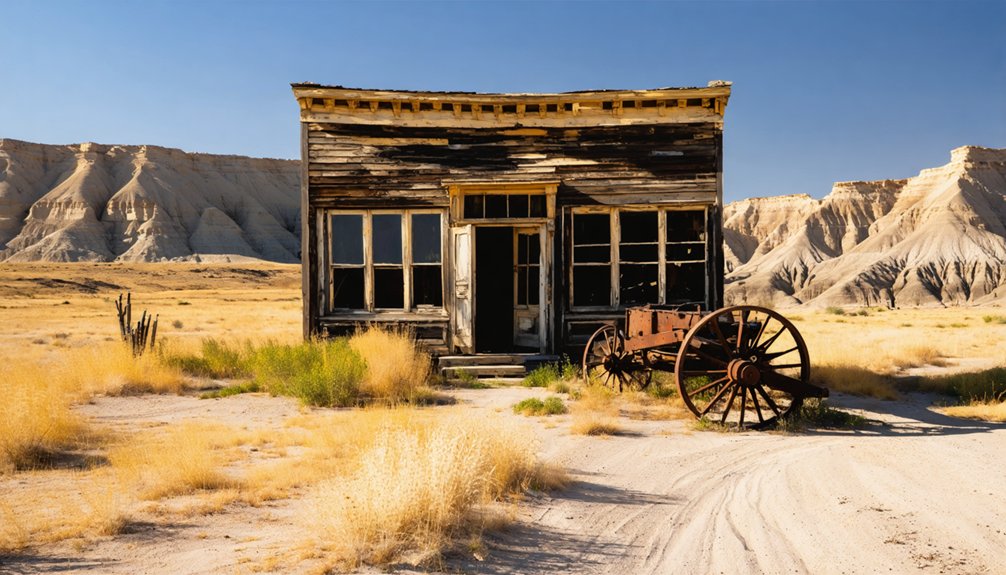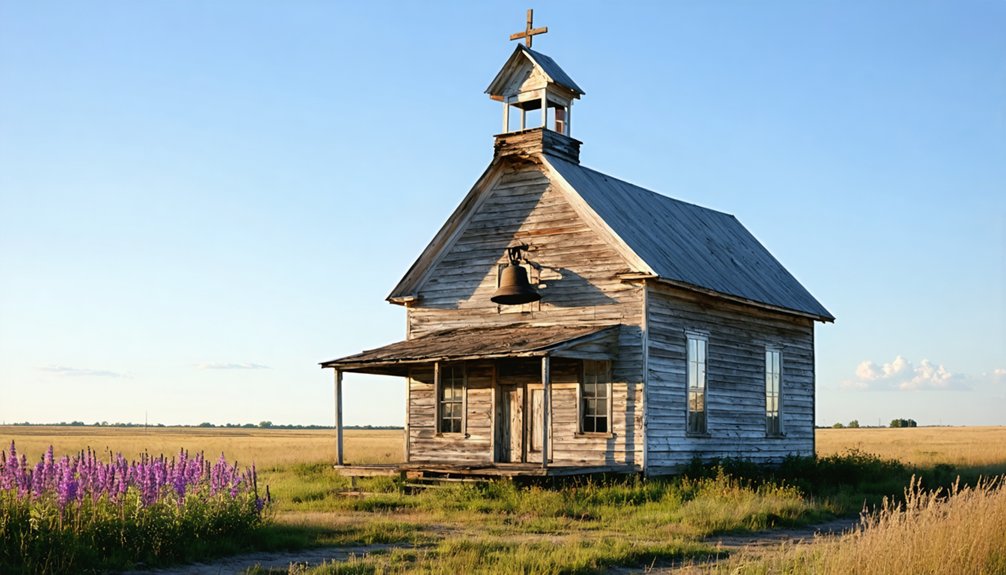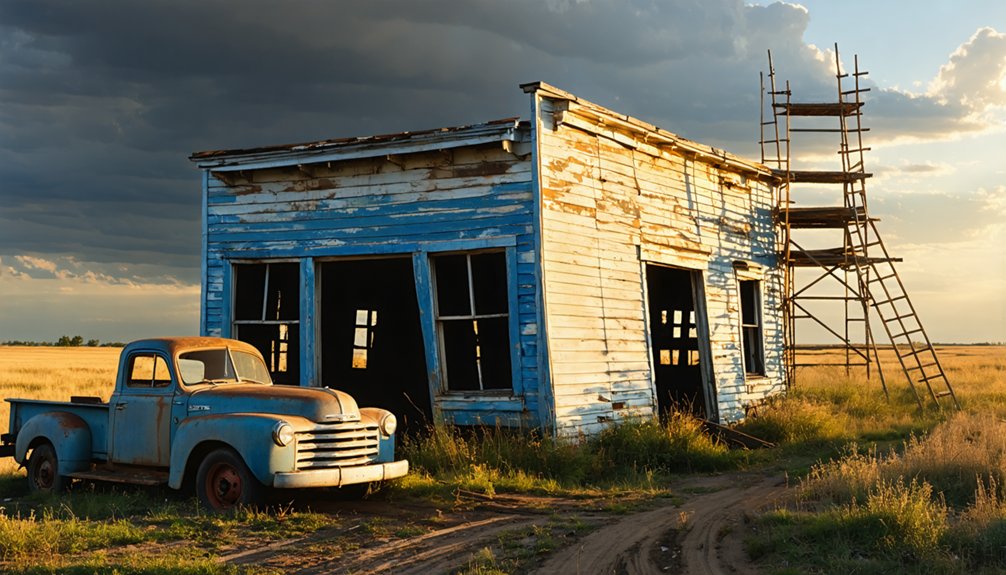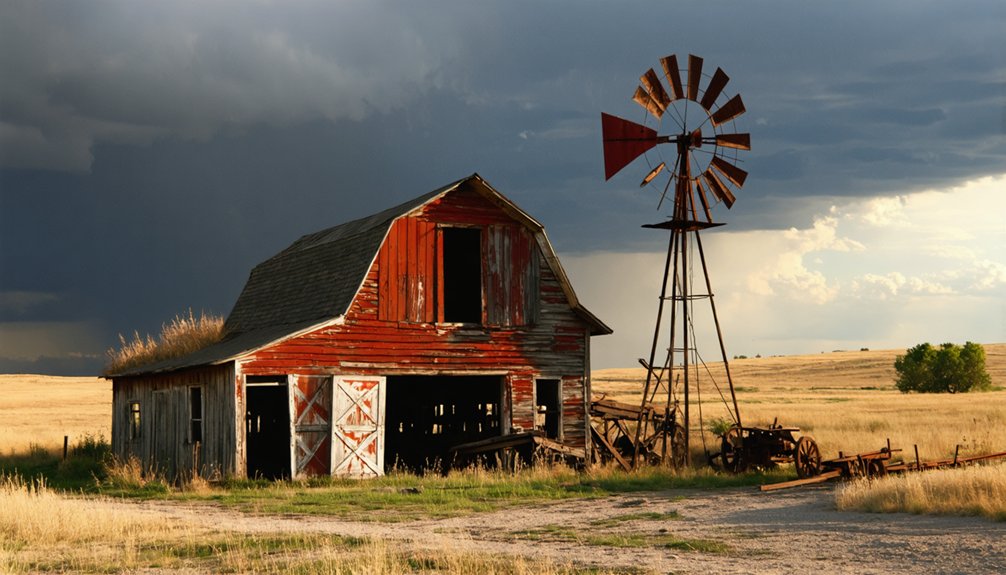You’ll find Big Bottom nestled in South Dakota’s Black Hills, where it emerged as a gold mining settlement in the late 1800s. At its peak around 1900, over 2,000 miners worked its deep shafts, processing 1.5 million tons of ore through 80-stamp mills. The ghost town‘s preserved structures include mining equipment, beehive ovens, and sawmills, with original homestead foundations still visible. The site’s rich history unfolds through its remaining landmarks and historic markers.
Key Takeaways
- Big Bottom emerged during the late 19th-century gold rush, developing into a sustainable rural community rather than a temporary mining camp.
- Mining operations employed over 2,000 workers by 1900, with extensive underground networks reaching depths of 1,550 feet.
- The ghost town preserves mining structures, beehive ovens, and equipment displays, accessible through two main entrance points.
- Located in South Dakota’s Black Hills region, the area features deep canyons, eroded buttes, and ponderosa pine forests.
- The town declined in the early 20th century due to dwindling mining operations and population shifts toward urban areas.
Origins and Early Settlement
While numerous ghost towns dot the Black Hills region of South Dakota, Big Bottom emerged as a distinct settlement during the late 19th century amidst the area’s gold rush era.
You’ll find that settler motivations extended beyond mining, as homesteaders like Mary Hynes staked claims on the rich grasslands despite the rugged terrain and challenging access. The remnants still visible today include foundations of early homesteads, revealing traces of the pioneering residents. Travelers often stopped here before continuing their journey to the last stop Badlands. The community dynamics reflected a diverse mix of ranchers, miners, and their families who built their lives around shared economic and social interests.
Rather than remaining a transient mining camp, Big Bottom developed into a sustainable rural community.
Unlike many temporary gold rush settlements, Big Bottom evolved into an enduring rural community in South Dakota’s Black Hills.
You’ll discover that settlers constructed sod houses using local materials, established essential infrastructure like post offices, and created social venues that fostered a lasting community identity amid the isolated Black Hills landscape.
Mining Operations and Economic Growth
As the Black Hills gold rush gained momentum in the late 19th century, Big Bottom’s mining operations evolved from simple placer deposits to sophisticated hard rock mining by 1880. By 1900, over 2000 workers provided labor for hundreds of mining claims across the region.
The economic impact was transformative, with mining shafts reaching depths of 900-1,550 feet by 1906. The area’s extensive underground network required 3.5 million feet of timber to support the tunnels and shafts. You’ll find the area’s mining technology advanced rapidly, introducing compressed air locomotives in 1901 and implementing cyanidization for improved gold recovery rates up to 94%.
- Advanced 80-stamp mills crushed massive ore volumes, processing 1.5 million tons by the early 1900s.
- Mining operations drove settlement growth and created jobs across milling, transport, and supply industries.
- The introduction of environmental regulations in the late 20th century changed operational practices to reduce contamination risks.
Life in the Mining Camp
You’d find miners at Big Bottom living in basic wooden or sod shelters, often sharing cramped quarters as they worked grueling 10-12 hour shifts in the mines.
After returning from their exhausting workday, you’d see these hardworking men gathering at the camp’s saloons and communal spaces, where they’d find entertainment through gambling and socializing with fellow miners.
Your daily routine would’ve included adapting to primitive conditions without running water, relying instead on nearby creeks while dealing with poor sanitation and seasonal weather challenges that tested even the heartiest settlers. Much like at the Carbonate Camp settlement, diseases and fires ultimately contributed to the town’s eventual decline.
Daily Miner Routines
Deep beneath the earth’s surface, miners in Big Bottom endured grueling 8 to 12-hour shifts that demanded both physical strength and unwavering focus.
You’d find them working in teams, drilling through rock, setting explosives, and hauling ore in rail carts. Workers relied on battery-operated lamps to illuminate their dangerous underground work for up to 8 hours at a time.
Mining superstitions ran deep, with workers carefully leaving the last bite of their meat pies for the Tommyknockers – spirits believed to protect those who showed them respect.
- Skilled miners inspected support timbers and cleared debris while watching for signs of cave-ins
- Teams coordinated complex work rituals, from explosives handling to operating the steel cage hoists
- Daily maintenance of pneumatic drills and other equipment was essential for survival underground
The demanding routine required constant vigilance, as every decision underground could mean the difference between life and death.
Living Quarters and Shelter
After their exhausting shifts underground, miners returned to modest living quarters that dotted the Big Bottom landscape.
You’d find various shelter types throughout the camp, from basic miners’ quarters to more substantial boarding houses and the superintendent’s residence. Most structures were built from local timber and greystone, designed to withstand the harsh Black Hills weather. Family-friendly tours of these preserved structures are now available for visitors to explore.
Living conditions varied depending on your status in the camp. If you were an average miner, you’d likely share communal spaces in boarding houses with basic kitchens and dining areas. The distinctive architectural style of these structures reflected the practical needs of mining camp life.
The more fortunate supervisors enjoyed private cabins with multiple rooms, including bedrooms, kitchens, and porches. While comfort wasn’t a priority, these dwellings offered essential protection from the elements, with thick walls and roofs keeping you warm through wood-burning stoves and fireplaces.
Community Gatherings After Work
While the mines fell silent each evening, Big Bottom’s social life came alive through vibrant community gatherings. You’d find miners congregating in saloons, sharing stories of the day’s work while enjoying card games and occasional live music.
These social traditions fostered strong communal bonding, as workers gathered around campfires for shared meals and storytelling sessions.
- Exchange essential mining information and safety alerts during informal gatherings
- Participate in community celebrations with music, dancing, and festive meals
- Join in baseball games and sports activities that brought the camp together
The town’s community hall became a hub for organized events, from religious services to holiday festivals.
You’d often witness miners leaving the last bite of their meals uneaten—a nod to the Tommyknockers, whose legends helped miners cope with their dangerous profession.
Geographic Features and Natural Resources

Situated in southwestern South Dakota‘s Black Hills region, Big Bottom Ghost Town occupies a diverse geological setting where the Great Plains shift into mountainous terrain.
You’ll find yourself surrounded by dramatic topographic features including deep canyons, eroded buttes, and rolling plains that stretch toward the James River Valley. The landscape’s ancient bedrock dates back roughly 2 billion years, with layers of limestone and marine fossils telling tales of prehistoric seas. The region experiences a continental climate with dramatic seasonal temperature swings.
The area’s natural resources once attracted settlers, offering rich mineral deposits, particularly gold, within the Black Hills’ rugged embrace. The Wounded Knee Massacre occurred approximately 40 miles east of this location in 1890.
You’ll notice the mixed forest habitat, dominated by ponderosa pine and bur oak, while the surrounding plains support limited agriculture. The region’s groundwater flows through sedimentary aquifers, though surface water remains scarce in this semi-arid environment.
Decline and Abandonment
During the early 20th century, Big Bottom’s fate mirrored many South Dakota ghost towns as the region faced multiple economic blows. The town experienced severe economic decline as mining operations dwindled and agricultural challenges mounted.
Population shifts accelerated as younger residents moved to urban areas seeking better opportunities, leaving behind an aging community that couldn’t sustain itself.
- Mining infrastructure fell into disuse as mineral resources were exhausted, eliminating the town’s primary economic driver.
- Railroad route changes and lack of transportation investment cut off crucial economic lifelines.
- Failed attempts to diversify beyond single industries left the community vulnerable to market downturns.
The combination of these factors ultimately led to Big Bottom’s abandonment, transforming it from a once-thriving community into another indication of the boom-and-bust cycle of frontier development.
Historical Landmarks and Remnants

You’ll find several mining structures still intact at Big Bottom, including remnants of sawmills and coal processing facilities that exemplify the town’s industrial heritage.
Historic markers and commemorative plaques guide visitors through the site, highlighting key locations like the old freight wagon routes and stone quarries.
The ghost town is accessible via two main entrance points, with the northern access road leading past preserved beehive ovens and mining equipment displays.
Mining Structures Still Standing
Traces of Big Bottom’s mining heritage remain scattered across the landscape, though most original structures have succumbed to time and nature.
You’ll find surviving structures primarily in the form of stone foundations and underground workings, while the forest has reclaimed many surface features.
Mining remnants include evidence of the town’s sophisticated engineering, from ventilation systems to rail spurs that once transported valuable ore.
- Limestone foundations mark where stamp mills once crushed gold-bearing ore
- Partially preserved rail beds with occasional spikes hint at narrow-gauge tracks
- Underground mine shafts and tunnels showcase period mining engineering
The most enduring features you’ll discover are those carved from stone or built below ground, as wooden structures and metal equipment have largely deteriorated or been salvaged over the decades.
Ghost Town Access Points
Three main historic transportation routes provide access to Big Bottom’s ghost town remains today. You’ll find old railroad sidings that once served the mining community, now converted to rough paths leading directly to the site.
Following the remnants of stagecoach trails, you can trace the original dirt tracks where ox-drawn wagons transported supplies to early settlers. Local gravel roads, following historic access corridors, offer the most reliable year-round entry points.
As you approach Big Bottom, you’ll spot key landmarks guiding your exploration. Stone foundations and partially standing structures serve as navigation markers, while abandoned mining features help orient visitors within the site.
Weather conditions can affect accessibility, particularly on unmaintained dirt routes, so checking local road conditions before your visit is essential.
Historic Markers and Plaques
Despite Big Bottom’s historical significance, the ghost town lacks official markers or commemorative plaques, with only the founder’s house foundation remaining as physical evidence of its past.
While other South Dakota ghost towns feature interpretive signage highlighting their histories, Big Bottom’s story remains unmarked. The South Dakota State Historical Society’s marker program, established in 1950, commemorates historically significant sites throughout the state, but hasn’t yet designated a marker for this location.
- Discover how other ghost towns like Galena and Carbonate showcase their heritage through weather-resistant metal and wooden markers
- Learn about the marker significance in preserving local history, including mining activities and community life
- Explore plaque design elements that typically feature historical text, photographs, and maps to help visitors visualize vanished structures
Preservation Efforts and Cultural Heritage

Preserving the heritage of Big Bottom has relied heavily on meticulous historical documentation and dedicated volunteer efforts. You’ll find that archival collections, including Will G. Robinson’s private files from his time as State Historical Society Secretary, have been essential in identifying and describing the town’s history.
Through community engagement and heritage tourism initiatives, local historical societies continue working to maintain the site’s cultural significance.
Local communities and historical groups work together, keeping Big Bottom’s heritage alive through tourism and cultural programs.
The preservation work combines thorough research methods, including field visits, library investigations, and oral histories from long-time residents. These efforts help piece together Big Bottom’s story even where physical remains are minimal.
Historical societies and volunteer groups collaborate to protect remaining structures, organize cultural events, and create educational programs that connect you with the authentic experiences of past residents.
Visitor Guide and Site Access
While Big Bottom’s remote location in western Meade County makes it challenging to visit, you’ll find the ghost town at coordinates 44°35′08″N 103°31′22″W on South Dakota’s Great Plains.
Site accessibility requires off-road travel or hiking from nearby rural roads, with no direct public access or marked trails leading to the location. For visitor safety, you’ll need to bring essential supplies and navigate using GPS, as there aren’t any facilities or signage at the site.
- Pack water, food, and emergency supplies – no services exist nearby
- Wear sturdy boots and protective clothing for uneven terrain
- Use GPS navigation and offline maps, as cell service is limited
Before heading out, check land ownership details to avoid trespassing, and inform others of your travel plans due to the site’s remote nature.
Frequently Asked Questions
Are There Any Reported Ghost Sightings or Paranormal Activity in Big Bottom?
You won’t find documented ghost encounters or spectral sightings specific to Big Bottom. While nearby ghost towns report paranormal activity through local folklore, there’s no official record of supernatural events at this location.
What Native American Tribes Originally Inhabited the Big Bottom Area?
You’ll find the Lakota and Dakota tribes dominated Big Bottom’s tribal history, though archaeological evidence shows indigenous peoples inhabited the area for over 7,000 years, highlighting its deep cultural significance.
Were Any Famous Outlaws Known to Hide in Big Bottom?
Don’t bet the farm on outlaw legends about Big Bottom – historical records haven’t turned up any notorious criminals hiding there, though the broader Black Hills region did shelter outlaws during the 1870s.
Did Big Bottom Have Its Own Newspaper During Its Peak Years?
You won’t find any historic publications from Big Bottom itself. Local journalism was handled by nearby towns’ newspapers, especially those from Philip and the broader Bad River region.
What Major Disasters or Epidemics Affected Big Bottom’s Population?
You’d be shocked how quickly disease outbreaks like influenza and dysentery decimated frontier towns. Economic decline from failing mines and floods also crushed Big Bottom’s population in the early 1900s.
References
- https://www.powderhouselodge.com/black-hills-attractions/fun-attractions/ghost-towns-of-western-south-dakota/
- https://www.youtube.com/watch?v=Glucs_Rq8Xs
- https://www.sdhspress.com/journal/south-dakota-history-2-2/some-black-hills-ghost-towns-and-their-origins/vol-02-no-2-some-black-hills-ghost-towns-and-their-origins.pdf
- https://www.sdpb.org/rural-life-and-history/2023-08-21/some-black-hills-ghost-towns-and-their-origins
- https://www.southdakotamagazine.com/scenic
- https://www.youtube.com/watch?v=_0WNYsFLSLA
- https://core.ac.uk/download/pdf/345016075.pdf
- https://en.wikipedia.org/wiki/List_of_ghost_towns_in_South_Dakota
- https://www.youtube.com/watch?v=uCaj6m8TXv4
- https://www.sdpb.org/learn/dakota-pathways/bigtownsandlittletowns



